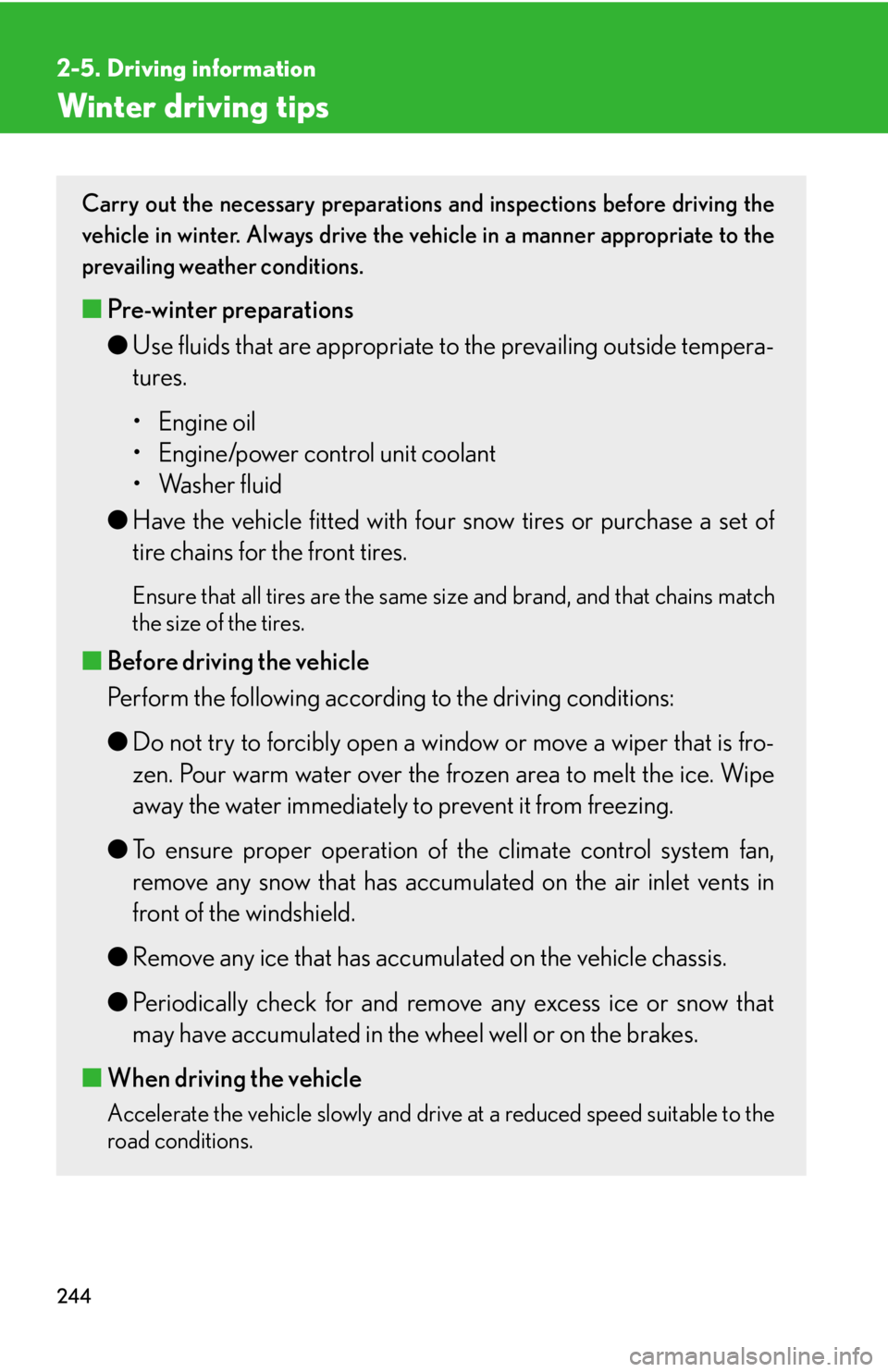climate control Lexus HS250h 2010 Do-it-yourself maintenance / LEXUS 2010 HS250H OWNERS MANUAL (OM75006U)
[x] Cancel search | Manufacturer: LEXUS, Model Year: 2010, Model line: HS250h, Model: Lexus HS250h 2010Pages: 608, PDF Size: 9.89 MB
Page 244 of 608

244
2-5. Driving information
Winter driving tips
Carry out the necessary preparations and inspections before driving the
vehicle in winter. Always drive the vehicle in a manner appropriate to the
prevailing weather conditions.
■ Pre-winter preparations
●Use fluids that ar
e appropriate to the prevailing outside tempera -
tures.
• Engine oil
• Engine/power control unit coolant
• Washer fluid
● Ha
ve the vehicle fitted with four snow tires or purchase a set of
tire chains for the front tires.
Ensure that all tires are the same si ze and brand, and that chains match
the size of the tires.
■ Before driving the vehicle
Perform the following accord ing to the driving conditions:
● D
o not try to forcibly open a w indow or move a wiper that is fro-
zen. Pour warm water over the frozen ar
ea to melt the ice. Wipe
away the water immediately to prevent it from freezing.
● T
o ensure proper operation of the climate control system fan,
remove any snow that has accumulated on the air inlet vents in
front of the windshield.
● R
emove any ice that has accumul ated on the vehicle chassis.
● P
eriodically check for and remove any excess ice or snow that
may have accumulated in the wheel well or on the brakes.
■ When driving the v
ehicle
Accelerate the vehicle slowly and drive at a reduced speed suitable to the
road conditions.
Page 565 of 608

565
6-1. Specifications
6
Vehicle specifications
■Treadwear
The treadwear grade is a comparative r
ating based on the wear rate of
the tire when tested under controll ed conditions on a specified gov-
ernment test course.
For example, a tire graded 150 would wear one and a half (1 - 1 /2) times as
well on the government course as a tire graded 100.
The relative performance of tires de pends upon the actual conditions of
their use
. Performance may differ significantly from the norm due to varia -
tions in driving habits, service practices
and differences in road characteris-
tics and climate.
■ Traction AA, A, B, C
The traction grades, from highest to lo
west, are AA, A, B and C, and
they represent the tire’s ability to stop on wet pavement as measured
under controlled condit ions on specified government test surfaces of
asphalt and concrete.
A tire marked C may have poor traction performance.
Warning: The traction grade assigned to t
his tire is based on braking
(straight ahead) traction tests and does not include cornering (turning) trac-
tion.
■ Temperature A, B, C
The temperature grades are A (the hi ghest), B
, and C, representing
the tire’s resistance to the generation of heat and its ability to dissipate
heat when tested under controlled conditions on a specified indoor
laboratory test wheel.
Sustained high temperature can cause the material of the tire to degenerate
and reduce tire life, and excessive temperature can lead to sudden tire fail -
ure.
Grade C corresponds to a level of performance which all passenger car
tir
es must meet under the Federal Mo tor Vehicle Safety Standard No. 109.
Grades B and A represent higher levels of performance on the laboratory
test wheel than the minimum r
equired by law.